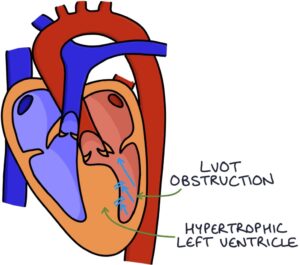Cardiomyopathy refers to disorders of the heart muscle. Cardio- refers to the heart, myo- refers to muscle and -pathy refers to disorder or disease.
Hypertrophic obstructive cardiomyopathy (HOCM) is a condition where the left ventricle becomes hypertrophic, with thickening of the muscle. This tends to asymmetrically affect the septum of the heart, blocking the flow of blood out of the left ventricle. This is referred to as left ventricular outflow tract (LVOT) obstruction.

HOCM is associated with an increased risk of heart failure, myocardial infarction, arrhythmias and sudden cardiac death. Arrhythmias and sudden death often occur during exertion, when there is extra demand on the heart. It is a notable cause of sudden cardiac death in young people, including high-performing athletes.
HOCM is an autosomal dominant genetic condition resulting from a defect in the genes for sarcomere proteins. It occurs in about 1 in 500 people.
Presentation
Most patients are asymptomatic.
Patients can present with non-specific symptoms. These may come on during exertion:
- Shortness of breath
- Fatigue
- Dizziness
- Syncope
- Chest pain
- Palpitations
Severe cases may present with symptoms of heart failure (e.g., cough, shortness of breath, orthopnoea, paroxysmal nocturnal dyspnoea and oedema).
Asking about a family history of heart disease and sudden death is important. It may occur in patients without a family history if a de novo (new) mutation occurs.
Examination findings:
- Ejection systolic murmur at the lower left sternal border (louder with the valsalva manoeuvre)
- Fourth heart sound
- Thrill at the lower left sternal border
If present, there may be signs of:
- Atrial fibrillation (irregularly irregular pulse)
- Mitral regurgitation (high-pitched, pan-systolic murmur)
- Heart failure
Investigations
An ECG may show left ventricular hypertrophy.
A chest x-ray is usually normal. It may show signs of pulmonary oedema if heart failure is present.
An echocardiogram or cardiac MRI is used to establish the diagnosis.
Genetic testing may be considered to establish the affected genes.
Management
Management depends on the severity and symptoms. Options include:
- Beta blockers
- Surgical myectomy (removing part of the heart muscle to relieve the obstruction)
- Alcohol septal ablation (a catheter-based, minimally invasive procedure to shrink the obstructive tissue)
- Implantable cardioverter defibrillator (for those at risk of sudden cardiac death or ventricular arrhythmias)
- Heart transplant
Patients are advised to avoid intense exercise, heavy lifting and dehydration.
ACE inhibitors and nitrates are avoided as they can worsen the LVOT obstruction.
Patients are also offered genetic counselling, and relatives may be tested.
Outcomes and Complications
There is a spectrum of outcomes:
- Minimal symptoms and a normal lifespan (most patients)
- Arrhythmias (e.g., atrial fibrillation)
- Mitral regurgitation
- Heart failure
- Sudden cardiac death
Other Types of Cardiomyopathy
Dilated cardiomyopathy is a condition where the heart muscle becomes thin and dilated. It may be genetic or secondary to other conditions (e..g, myocarditis).
Alcohol-induced cardiomyopathy is a type of dilated cardiomyopathy caused by long-term alcohol use.
Restrictive cardiomyopathy is when the heart becomes rigid and stiff, causing impaired ventricular filling during diastole.
Arrhythmogenic cardiomyopathy is a genetic condition where the heart muscle is progressively replaced with fibrofatty tissue. It becomes prone to ventricular arrhythmias. It is a notable cause of sudden cardiac death in young people, including high-performing athletes.
Takotsubo cardiomyopathy is a condition with a rapid onset of left ventricular dysfunction and weakness. This often follows severe emotional stress, for example, the death of a long-term partner. For this reason, it is known as broken heart syndrome. It tends to resolve spontaneously with time.
Last updated March 2023
Now, head over to members.zerotofinals.com and test your knowledge of this content. Testing yourself helps identify what you missed and strengthens your understanding and retention.

